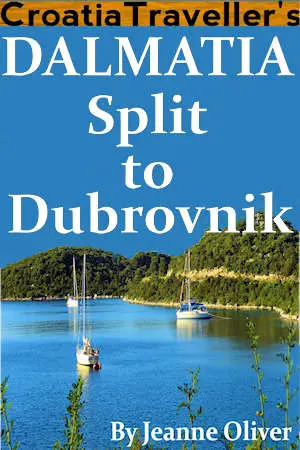Sightseeing in Trogir is a joy. It's a small town and Trogir's sights are conveniently clustered together, making it an easy walk and easy to understand why it is a UNESCO World Heritage Site
Art lovers who are looking for a sophisticated and detailed explanation of Trogir's art should order a copy of Croatia: Aspects of Art, Architecture and Cultural Heritage
in which several art experts explain the significance of Trogir's unique contribution to Dalmatian culture.
Start your walking tour from the Renaissance city gate (the main entrance to the town from the car and bus park). Above the gate is a statue of the town's protector, the Blessed Ivan Orsini. Nearby is the town museum which gives a good overview of Trogir's history. It's open 9am-2pm Monday to Saturday.
Cathedral of St Lovro
Continue to the town centre. On the northern side of the main square is the magnificent cathedral of St Lovro, built from the 13th to the 15th centuries and considered one of the Adriatic's most architecturally and artistically important monuments. It represents the first example in Dalmatia of the Gothic style that was sweeping continental Europe.
The cathedral highlights the artistry of Master Radovan, Dalmatia's finest builder. His masterpiece is the western portal, now known as 'Radovan's Portal'. The significance of this work is how the Romanesque structure of the portal encloses the Gothic tendency to humanize the Biblical story it depicts. Notice the central scene of the tympanum in which Radovan conveys the Madonna's intimate relationship with the child by showing her uncovering the face of the infant. Beneath, Christ is depicted as a normal baby resisting the women bathing him. On the left side of the tympanum, notice the realistic scene of a shepherd with a water flask, dogs and a basket for making butter.
The reliefs representing the months of the year are rife with detail. In December boars are slaughtered for sausages; in January the sausages are smoked over the hearth while an old man warms himself and a youth pours wine into a cup. The god Mars, clothed in Roman armour and weapons personifies March while in April a young man shears a sheep.
Perhaps the most striking figures are the freestanding sculptures of Adam and Eve in which he achieves a remarkable fluidity in the human figures he molded. Adam and Eve are depicted nude--a first in Dalmatian sculpture.
Other masterful artisans also contributed to the exterior of the cathedral. The elegant bell tower illustrates succession of styles. Begun in the 14th century, the ground floor is Romanesque; the first story is early Gothic (early 15th century); the second story was built by Matej Gojkovic in a late Gothic style in 1420; the third story is a Renaissance style while the top sports mannerist statues added in the 17th century.
The interior of the Cathedral is no less astonishing than the exterior. The Chapel of Blessed John Orsini is a Renaissance masterpiece created by Nikola Firentinac (1418-1506), Andrija Alesi (1456-1480) and Ivan Duknovic (1440-1508), all trained in Italy. Although it took four decades to complete, the freestanding sculptures of Christ and the twelve apostles topping a basamento of nineteen energetic putti are remarkable of the harmony of the whole and the humanism of the individual pieces.
Notice also the baptistery (1484) created by Andrija Alesi, dominated by the low relief of the bearded St Jerome, who is the patron saint of Dalmatia. In this scene, a lion watches over the old saint while two dragons emerge from the rocks to the left.
Opening Hours
The cathedral is open Monday to Saturday from 8am to noon November to March and from 8am to 6pm Monday to Saturday and noon to 6pm, Sunday April to October. There is an admission charge to enter the cathedral although Radovan's Portal can be seen from outside the gates.
Other Monuments
Outside the cathedral, Firentinac's work is evident in the relief of "Justice" in the loggia of the 15th-century courthouse. The stone table where the judges sat is still there with the relief depicting Justice and the two patron saints of Trogir on the wall behind. The equestrian relief by Ivan Mestrovic on the rear wall provides a startling modernist contrast.
Notice as well the sculpture of St Sebastian on the adjacent clock tower, part of the former church of St Sebastian.
The east side of the town square is devoted to two palaces: the "Old" Cipiko palace is the smaller and displays a beautiful triforium. The "New" Cipiko palace has late-Gothic triforia on the first and second floors. Both are the work of Firentinac and Alesi.
On the east side of town, don't miss the church of St John the Baptist, dating from the 13th century with a magnificent portal and bell tower. In the church is a "Pieta" also by Firentinac.
On the waterfront is the imposing Kamerlengo fortress which used to be connected to the city walls. It was built by the Genoans in the 14th century and in 1941 it was the site of a massacre of locals by the Fascist occupiers. A memorial plaque notes the event.
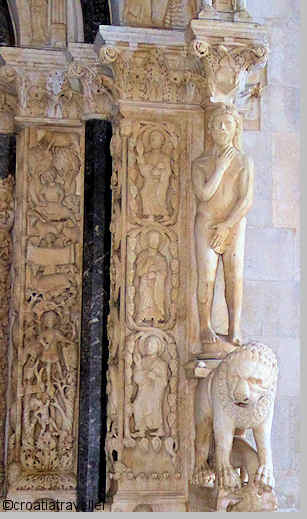
Adam
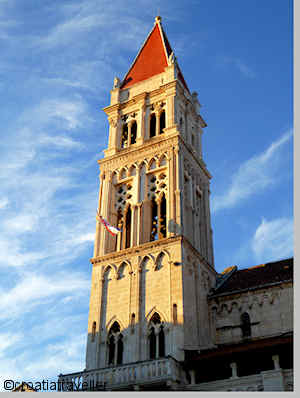
Cathedral St Lovro Bell Tower
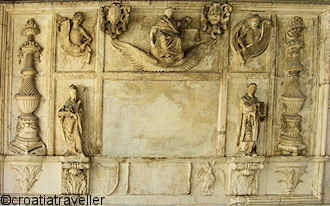
"Justice" Frieze on Trogir's Hall of Justice
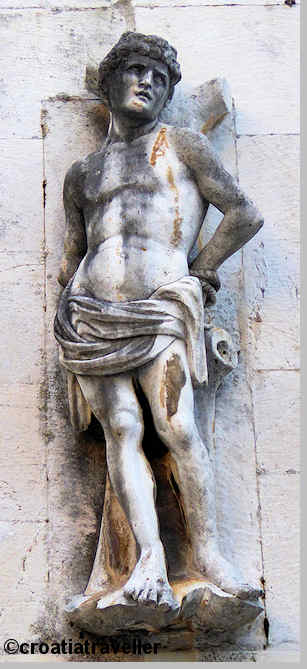
St Sebastian
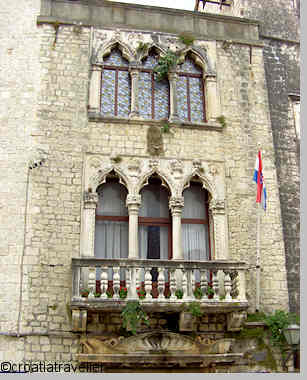
"New" Cipiko Palace
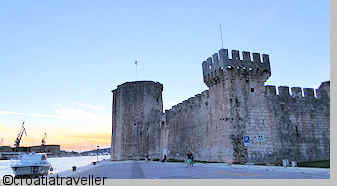
Kamerlengo Fortress
Join the Croatia Traveller Group
Recommended Experiences
©CroatiaTraveller 2005-2024 All rights reserved

